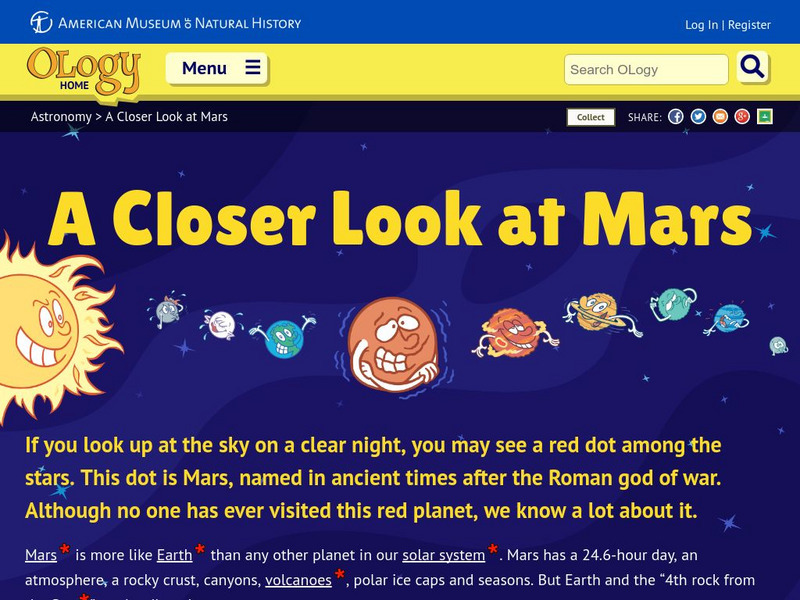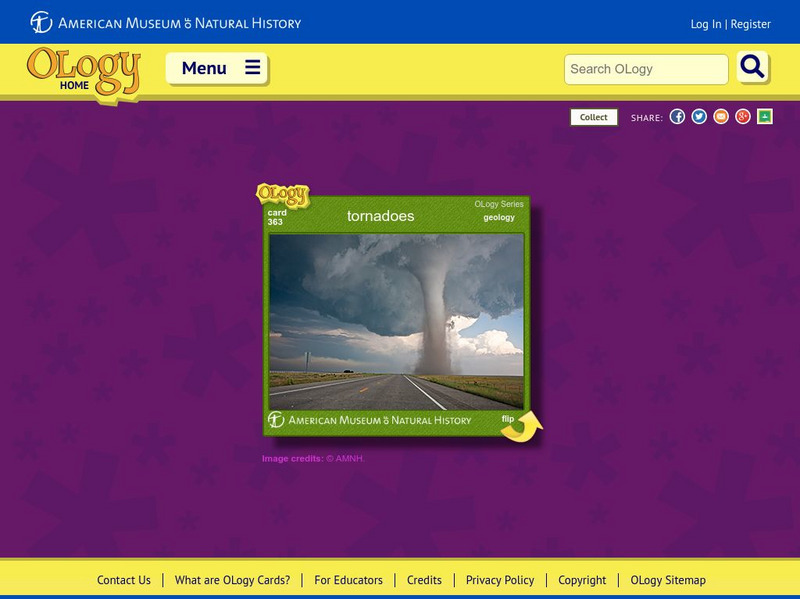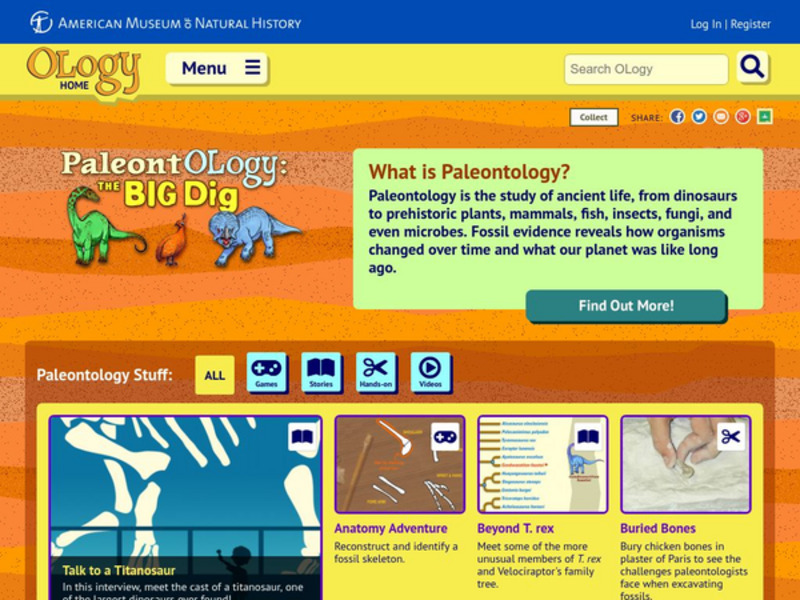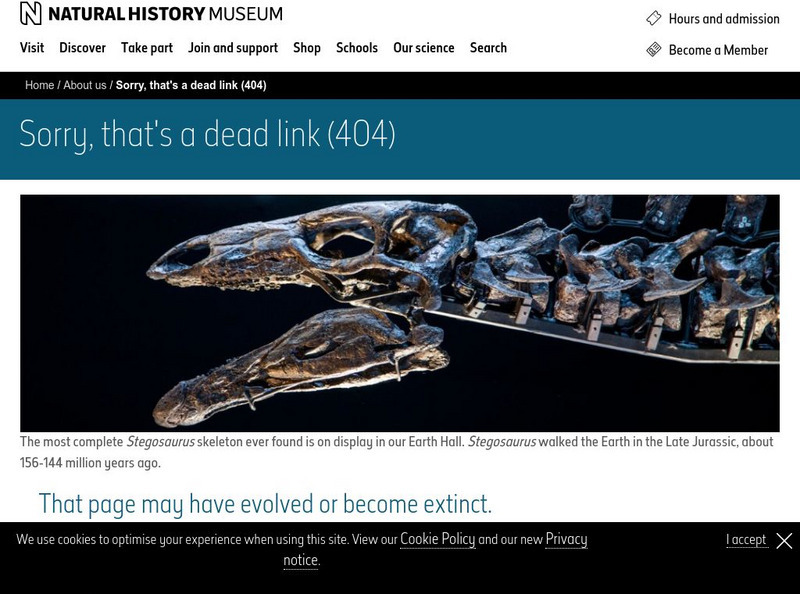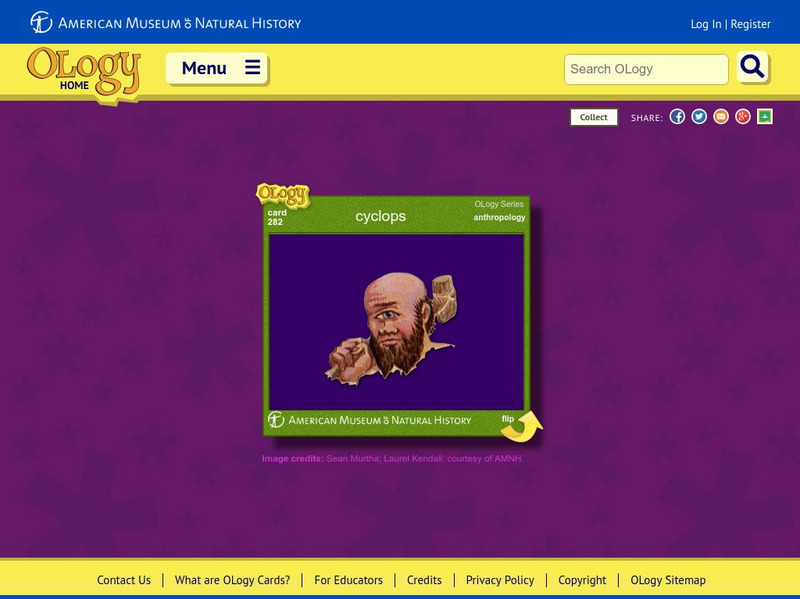Idaho State University
Idaho Museum of Natural History
This site contains many links to ongoing exhibits, helpful natural history information, and other fun and educational links, including a "Just for Kids" link. Great place for the natural history bunk!
San Diego Natural History Museum
San Diego Natural History Museum: Fossil Field Guide: Albertosaurus
A look at what fossil evidence reveals about the life and ecological interactions of the Albertosaurus dinosaur.
American Museum of Natural History
American Museum of Natural History: O Logy: A Closer Look at Mars
If you look up at the sky on a clear night, you may see a red dot among the stars. This dot is Mars, named in ancient times after the Roman god of war. Although no one has ever visited this red planet, we know a lot about it. This site...
American Museum of Natural History
American Museum of Natural History: Tornadoes O Logy Card
Flip this interactive card to start learning about tornadoes, nature's most powerful storms. Answer multiple-choice and fact-or-fiction questions and review some fast facts about tornadoes.
American Museum of Natural History
American Museum of Natural History: O Logy: Paleontology: The Big Dig
On this site, you will learn all about Paleontology, the study of ancient life. It defines paleontology and provides links to games, stories, videos, and hands-on activities.
American Museum of Natural History
American Museum of Natural History: Resources for Learning: The Path to El Nino
Through this resource, students explore the history, causes, effects, and patterns of El Nino.
Other
Santa Barbara Museum of Natural History: The Chumash People of California
A thorough look at the Chumash people of California. Read about their unique plank canoes, basketry, language, and cave paintings. Many pictures of artifacts and drawings accompany the information.
University of Florida
Florida Museum of Natural History: Shark Basics
You will find the most commonly asked shark questions in this comprehensive site. Topics include shark basics, shark biology, shark conservation, shark attacks, and shark research.
American Museum of Natural History
American Museum of Natural History: Crazy Camouflage
Create a flounder fish that's hard to spot. In this hands-on activity, students gather evidence to explore how camouflage helps animals survive.
American Museum of Natural History
American Museum of Natural History: Grow Rock Candy
Students can carry out an investigation using sugar and water to determine whether heating or cooling a substance may cause changes that can be observed. This activity reinforces the ideas that the properties of materials can change when...
American Museum of Natural History
American Museum of Natural History: Map Your World
Students can follow these easy steps to develop a model (drawing) of their room and the things in it. Then they can broaden the drawing to include their entire floor, apartment, or house.
Natural History Museum
Natural History Museum: Meteorites
Brief article examines what meteorites are, the different types, and where they came from.
University of Texas at Austin
Texas Memorial Museum: Hall of Geology and Paleontology Educator Guide [Pdf]
An educator guide to visiting the Texas Memorial Museum. Guide includes pre-visit activities, activities during your visit, post-visit activities, words to know, and websites for educators and students.
American Museum of Natural History
American Museum of Natural History: O Logy: What's the Big Idea? Paleontology
Snapshot reference on paleontology explains how the fossil record drives this area of science.
American Museum of Natural History
American Museum of Natural History: Glowing in the Ocean
This site focuses on underwater animals that create their own light using bioluminescence. It also provides the lyrics and audio of a catchy tune putting bioluminescence in the spotlight.
American Museum of Natural History
American Museum of Natural History: O Logy: Arctic Story Puzzles
Construct a story about the Inuit or the polar bear from a series of pictures that can be put together in a sequence.
American Museum of Natural History
American Museum of Natural History: O Logy: Stuff to Do: Start a Rock Collection
Step-by-step details for building a rock collection, beginning with collecting specimens, moving on to observing and sorting rocks, and finishing with displaying the collection. Includes a data table for keeping track of all your...
Smithsonian Institution
National Museum of Natural History: Arctic Studies Center: Lemmings
This Smithsonian website has a brief, but thorough, article on the Lemmings that also includes a picture and a quote from naturalist Edward Nelson.
Burke Museum
Burke Museum of Natural History and Culture: The Spider Myths Site
Are spiders insects? Do you really swallow spiders while you're sleeping? Myths and questions related to spiders are addressed on this site. Links to additional information can also be found here.
American Museum of Natural History
American Museum of Natural History: O Logy: Cyclops
Find out the background of the mythical cyclops from Greek mythology. It might surprise you! Flashcard format.
American Museum of Natural History
American Museum of Natural History: Domestication O Logy Card
An interactive program educating learners about the domestication of animals.
American Museum of Natural History
American Museum of Natural History: Drinker Nisti O Logy Card
Flip this interactive card to start learning about Drinker Nisti, an ornithopod from the Late Jurassic-Early Cretaceous period. Answer multiple-choice and fact-or-fiction questions and review some fast facts about this dinosaur.
American Museum of Natural History
American Museum of Natural History: Alxasaurus Elesitaiensis O Logy Card
Flip this interactive card to start learning about Alxasaurus Elesitaiensis, a big-clawed therizinosaur. Answer multiple-choice and fact-or-fiction questions and review some fast facts about this herbivorous dinosaur.
American Museum of Natural History
American Museum of Natural History: Protoceratops Andrewsi O Logy Card
Flip this interactive card to start learning about Protoceratops Andrewsi. Answer multiple-choice and fact-or-fiction questions and review some fast facts about this herbivorous dinosaur.


